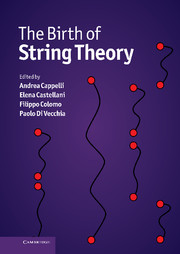Book contents
- Frontmatter
- Contents
- List of contributors
- Photographs of contributors
- Preface
- Abbreviations and acronyms
- Part I Overview
- EARLY STRING THEORY
- Part II The prehistory: the analytic S-matrix
- Part III The Dual Resonance Model
- Part IV The string
- TOWARDS MODERN STRING THEORY
- Part V Beyond the bosonic string
- Part VI The superstring
- Part VII Preparing the string renaissance
- Appendix A Theoretical tools of the Sixties
- Appendix B The Veneziano amplitude
- Appendix C From the string action to the Dual Resonance Model
- Appendix D World-sheet and target-space supersymmetry
- Appendix E The field theory limit
- Index
Preface
Published online by Cambridge University Press: 05 May 2012
- Frontmatter
- Contents
- List of contributors
- Photographs of contributors
- Preface
- Abbreviations and acronyms
- Part I Overview
- EARLY STRING THEORY
- Part II The prehistory: the analytic S-matrix
- Part III The Dual Resonance Model
- Part IV The string
- TOWARDS MODERN STRING THEORY
- Part V Beyond the bosonic string
- Part VI The superstring
- Part VII Preparing the string renaissance
- Appendix A Theoretical tools of the Sixties
- Appendix B The Veneziano amplitude
- Appendix C From the string action to the Dual Resonance Model
- Appendix D World-sheet and target-space supersymmetry
- Appendix E The field theory limit
- Index
Summary
In May 2007 we organized a workshop on the origin and early developments of string theory at the Galileo Galilei Institute for Theoretical Physics in Arcetri (Florence). A fair number of researchers who had contributed to the birth of the theory participated and described, according to their personal recollections, the intriguing way in which the theory developed from hadron phenomenology into an independent field of research. It was the first occasion on which they had all been brought together since the 1975 conference in Durham, which represented the last meeting on string theory as applied to hadronic physics.
The workshop in Arcetri was a success: the atmosphere was enthusiastic and the participants showed genuine pleasure in discussing the lines of thought developed during the years from the late Sixties to the beginning of the Eighties, mutually checking their own reminiscences. This encouraged us to go on with the project we had been thinking of for some time, of an historical account of the early stages of string theory based on the recollections of its main exponents. We were fortunate enough to have on board practically all the physicists who developed the theory. While some of the contributions to this Volume originated from the talks presented at the meeting, most of them have been written expressly for this book.
In starting this project we were motivated by the observation that the history of the beginnings and early phases of string theory is not well accounted for: apart from the original papers, the available literature is rather limited and fragmentary.
- Type
- Chapter
- Information
- The Birth of String Theory , pp. xxi - xxiiiPublisher: Cambridge University PressPrint publication year: 2012



